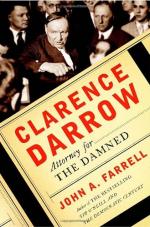|
This section contains 4,295 words (approx. 15 pages at 300 words per page) |

|
SOURCE: "Clarence Darrow's Contribution to Literary Naturalism: 'An Eye for an Eye'," in Revue des Langues Vivantes, Vol. XXXVI, No. 4, 1970, pp. 390-400.
In the following essay, Shuman examines naturalistic elements in An Eye for an Eye, in particular as they highlight Darrow's concern for individualism and revolt.
The most renowned criminal lawyer in the history of American jurisprudence is undoubtedly Clarence Seward Darrow. Admitted to the Bar in 1875, when he was only eighteen years old, Darrow had established himself and gained a national reputation before the turn of the century by winning an acquittal for Eugene V. Debs in the American Railway Union strike case of 1894.
However, Darrow, who was to live until 1938, gained his most substantial reputation during the last half of his long life for his involvement in such illustrious and sensational contests as the Leopold and Loeb case (1924); the Scopes trial (1925), in which his opponent...
|
This section contains 4,295 words (approx. 15 pages at 300 words per page) |

|


